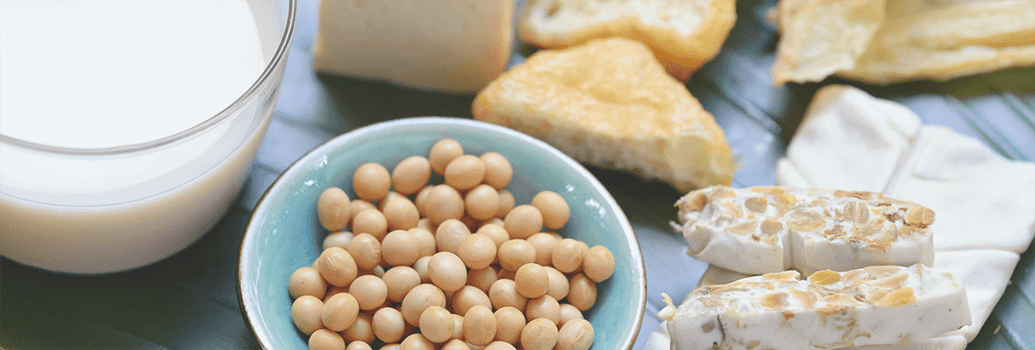The soybean is a legume. A staple in Asian diets for centuries, soy foods include traditional Asian foods like soy milk, tofu, tempeh and miso.
Interest in the health benefits of soy first emerged when scientists observed that Asian populations consuming their traditional diets have much lower rates of heart disease and some cancers compared to people in Western populations.
With all the research and knowledge on the benefits of soy, there are now even more soy foods for us to choose from, like yoghurts, cheese, breads, breakfast cereals and meat alternatives like burger patties, soy sausages and sandwich slices.
Why is soy so nutritious?
High quality protein
Protein helps to support the growth and repair of your body’s cells. Amino acids are the building blocks of protein and while your body can make some of them, there are nine amino acids that need to come from your diet. Soy protein contains all of the nine essential amino acids and is therefore called a high quality protein.
High in fibre
Like all legumes, soy beans are high in fibre. In fact, just a cup (200g) of cooked soy beans has more than 14 grams of fibre, which is half the recommended daily intake!
Protective phytoestrogens
Phytoestrogens are natural occurring substances found in plant foods. Different types of phytoestrogens are found in wholegrains, vegetables, legumes, fruits, nuts and seeds.
While phytoestrogen molecules are similar in shape and size to the human body’s oestrogen, they're not the same and act differently in the body. The main type of phytoestrogens found in soy are isoflavones. It is the isoflavones in soy that give soy foods their many protective health benefits.
The benefits of isoflavones include:
- important antioxidant and anti-inflammatory properties
- mimicking some of the positive effects of oestrogens, like reducing cholesterol and hot flushes
- acting in opposition to the harmful effects of oestrogen like increasing heart disease risk and weight gain.
The health benefits of soy
Soy foods are a great choice for good health. The body of scientific evidence from many thousands of research papers suggests many health protective benefits of consuming soy beans and soy foods.
Soy for healthy hearts
Soy foods are great for protecting your heart.
The soy protein, fibre and isoflavones present in soybeans can help to:
lower your blood cholesterol
lower your blood pressure
help to keep your blood vessels flexible as you age.
Did you know?
Research shows that soy protein can lower LDL or ‘bad’ cholesterol by 5%.
Benefits of soy for men and women
Research shows that soy can protect against cancers of the breast, prostate and bowel. In fact, recent studies have shown that women who have between 1-1½ servings of soy a day when they were children and adolescents can reduce their risk of breast cancer later in life by up to 60%.
For women who have breast cancer, research shows that those with the highest isoflavone intake from soy foods had a 17% lower risk of death and were 25% less likely to have their breast cancer return than women who did not eat soy foods.
Benefits of soy for menopause
For women in Asian countries who regularly eat soy as part of their traditional diets, hot flushes are rare. A review of studies in this area has shown that the isoflavones in soy can help to reduce the frequency and severity of hot flushes by more than 20%. In fact, soy beans and tofu are recommended by the North American Menopause Society to help reduce menopausal symptoms.
Soy for healthy bones
While more research is needed in this area, there's evidence that the isoflavones in soy foods may help to strengthen bones by increasing bone formation and mineral density.
How much should I consume?
While traditional Asian cultures include up to three serves of soy foods each day, if you include just one serve a day you can obtain nutritional and health benefits.
One serving of soy is:
Tips to include more soy
One of the easiest ways to include more soy in your diet is to swap dairy milk with soy milk. Along with its important isoflavones, a calcium-enriched soy beverage provides you with as much calcium as regular dairy milk but with no cholesterol, animal fat or lactose.
Along with the simple milk swap, soy yoghurts, breads and cereals are all great ways to boost your soy intake.
You could also try:
Soy beans in soups, pasta sauces or stews
Edamame are soybeans in their pod that you can enjoy warm or tossed through a salad
Tofu – try it firm, smoked or marinated in stir-fries, curries or on the BBQ
Tempeh – slice and grill, barbeque or panfry and add to stir-fries or salads
Miso – add to soups, sauces and marinades in place of regular stock
Soy-nuts – a tasty snack of roasted soy beans
Soy burgers, sausages and slices are a great meat alternative that is tasty, low saturated fat
TVP – also known as textured vegetable protein, can be used as an alternative to mince in pasta sauces or casseroles

